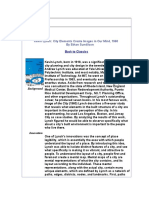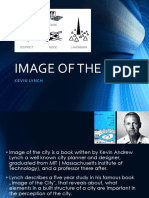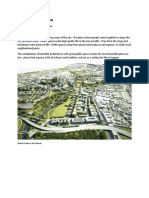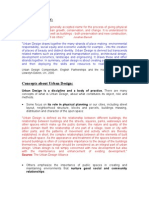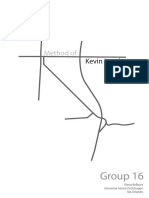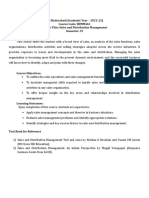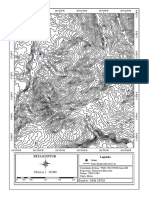Kevin Lynch
Kevin Lynch
Uploaded by
Sayali KhokaleCopyright:
Available Formats
Kevin Lynch
Kevin Lynch
Uploaded by
Sayali KhokaleOriginal Description:
Copyright
Available Formats
Share this document
Did you find this document useful?
Is this content inappropriate?
Copyright:
Available Formats
Kevin Lynch
Kevin Lynch
Uploaded by
Sayali KhokaleCopyright:
Available Formats
KEVIN A.
LYNCH
NAME : PRABHAT SHARMA
CLASS : 4
TH
YAER A
ROLL NO. : 20
Kevin A. Lynch
Kevin A. Lynch
Kevin Andrew Lynch (1918 Chicago, Illinois - 1984 Martha's Vineyard, Massachusetts) was an
American urban planner and author. His most influential books include The Image of the
City (1960) and What Time is This Place? (1972).
The book by kevin lynch
the image of the city
Biography
Lynch studied at Yale University, Taliesin (studio) under Frank Lloyd Wright, Rensselaer Polytechnic
Institute, and received a Bachelor's degree in city planning from MIT in 1947.He worked in
Greensboro, NC as an urban planner but was recruited to teach at MIT by Lloyd Rodwin. He began
lecturing at MIT the following year, became an assistant professor in 1949, was tenured as an
associate professor in 1955, and became a full professor in 1963.
Lynch provided seminal contributions to the field of city planning through empirical research on how
individuals perceive and navigate the urban landscape. His books explore the presence of time and
history in the urban environment, how urban environments affect children, and how to harness
human perception of the physical form of cities and regions as the conceptual basis for good urban
design.
Parallel to his academic work, Lynch practiced planning and urban design in partnership with
Stephen Carr, with whom he founded Carr Lynch Associates in Cambridge, Massachusetts. Lynch
died at his summer home in Martha's Vineyard in 1984.
The Image of the City
Lynch's most famous work, The Image of the City published in 1960, is the
result of a five-year study on how observers take in information of the city.
In this book, Lynch argues that people in urban situations orient themselves
by means of mental maps. He compares three American cities (Boston,
Jersey City, and Los Angeles) and looks at how people orient themselves in
these cities.
People who move through the city engage in way-finding. They need to be
able to recognize and organize urban elements into a coherent pattern.
Lynch reported that users understood their surroundings in consistent and
predictable ways, forming mental maps with five elements:
1. Paths, the streets, sidewalks, trails, and other channels in which people
travel;
2. Edges, perceived boundaries such as walls, buildings, and shorelines;
3. Districts, relatively large sections of the city distinguished by some
identity or character;
4. Nodes, focal points, intersections or loci;
5. Landmarks, readily identifiable objects which serve as external
reference points.
PATHS - channels along which the observer
customarilymoves
EDGE - An edge is defined as a
boundary between two areas, including
shores, walls, wide streets, breaks
between buildings, and open spaces.
The bluffs of Mankato serve as an important
edge. They separate the city between the
lower valley and the upper highland.
ENTERTAINMENT DISTRICT- is
located downtown on River Front
Street. It includes the Civic
Center and a Movie Theater.
Minnesota State University serves Mankato as
an important landmark. Since 1867, the
university has served as a symbol of one of the
largest and most prestigious colleges in the state.
The River Hills Mall has been around
for a decade. It has a wide variety of
stores such as Target, Sears, J.C.
Pennys, Herbergers and Scheels.
An environmental image has three components: identity (the recognition of urban elements as separate entities),
structure (the relation of urban elements to other objects and to the observer), and meaning (its practical and
emotional value to the observer).
They should design the city in such a way that it gives room for three related movements: mapping, learning, shaping.
1. First, people should be able to acquire a clear mental map of their urban environment.
2. Second, people should be able to learn how to navigate in this environment by training.
3. Third, people must be able to operate and act upon their environment.
Are locative services undermining the potential for exploration and unexpected encounters with new places and people, when our
movements are guided and goal-oriented? ????
Lynch himself feels that disorientation is the cause of fear and anxiety, and already claims that [t]o become completely
lost is perhaps a rather rare experience for most people in the modern city (p. 4). Yet under controlled circumstances he
acknowledges that there is some value in mystification, labyrinth, or surprise in the environment
One such question is the extend to which our way-finding shifts from orienting ourselves to mostly objective urban elements to
become increasingly subjective by means of locative media technologies. ??????
The element of visibility is crucial here. Lynch is talking about elements of the city that are publicly visible to all
people.
In the image of the city, discussed the image of the spatial environmentthe mental representation of the character and structure of
the geographic worldas a scaffold to which we attach many meanings and a guide by which we can order our movements. This
image has an immediate practical role in our lives, and also a deeper psychological one....
Many parallel statements can be made about the environmental image of time.... Both have intimate connections with the aesthetics
of landscape and more general implications for social structure and social change. It is evident that we should think of an
environmental image that is both spatial and temporal, just as we must design settings in which the distribution of qualities in both
time and space are considered."
What Time is This Place?
Kevin Lynch's book deals with this human sense of time, a biological rhythm that may follow a different beat from that dictated by
external, "official," "objective" timepieces.
In one's own image of a city or of a larger environment, the sense of place is inextricably meshed with the sense of timea financial
district that bustles on Friday is transformed into a lifeless concrete desert by Sunday, or the deposits of slow historic change can be
spotted around a neighborhood, or renewal bulldozers can suddenly revive a long-suppressed memory of time past. Time and Place
Timeplaceis a continuum of the mind, as fundamental as the spacetime that may be the ultimate reality of the material world.
It opens with several case histories of cities
transformed by time: London after the Great Fire of
1666;
Bath, the preserved city, embedded in the amber of
the eighteenth century;
Stoke-on-Trent, an industrial wasteland, a disaster
area not because it was destroyed but because it was
built;
Ciudad Guyana, a new but not an instant city;
and Havana, container for social revolution.
Plan for rebuilding the City of London (St Paul's Cathedral is indicated in red), 1666
You might also like
- Summary: Design With NatureDocument16 pagesSummary: Design With Naturebulanbiru42% (12)
- Image of The City by Kevin LynchDocument2 pagesImage of The City by Kevin LynchArkitek100% (1)
- Image of The CityDocument11 pagesImage of The CityAman Kanaiya50% (4)
- Dynamic Urban Design: A Handbook for Creating Sustainable Communities WorldwideFrom EverandDynamic Urban Design: A Handbook for Creating Sustainable Communities WorldwideRating: 4.5 out of 5 stars4.5/5 (2)
- BWS NG 1998Document219 pagesBWS NG 1998lay100% (1)
- Kevin LynchDocument38 pagesKevin LynchJanani devi RamkumarNo ratings yet
- Image of The CityDocument9 pagesImage of The CityAnntonette Mercado100% (2)
- Planning Theories SUMMARYDocument23 pagesPlanning Theories SUMMARYCharms QueensNo ratings yet
- ARC251 02the Scope of Urban DesignDocument9 pagesARC251 02the Scope of Urban Designscarface6usNo ratings yet
- Property, Patrimony & TerritoryDocument481 pagesProperty, Patrimony & TerritoryJaysan Ray Ngujo Chee100% (7)
- Urban Design Space, Aesthetics & PatternDocument18 pagesUrban Design Space, Aesthetics & PatternJosh Lacanilao100% (1)
- Planning and Urban Design StandardsFrom EverandPlanning and Urban Design StandardsRating: 3.5 out of 5 stars3.5/5 (6)
- Prepared By:-Shifa Goyal B.Arch 2016-21 Roll No. 22 Faculty of Architeture Urban Planner and AuthorDocument14 pagesPrepared By:-Shifa Goyal B.Arch 2016-21 Roll No. 22 Faculty of Architeture Urban Planner and AuthorMonishaNo ratings yet
- Kevin LynchDocument7 pagesKevin LynchricpevanaiNo ratings yet
- Image of The CityDocument26 pagesImage of The CityMinorin Quintanar100% (3)
- Kevin LynchDocument24 pagesKevin LynchEnshaS50% (2)
- Images of CityDocument65 pagesImages of CityCJ OngNo ratings yet
- Kevin Lynch: City Elements Create Images in Our Mind, 1960 by Ethan SundilsonDocument4 pagesKevin Lynch: City Elements Create Images in Our Mind, 1960 by Ethan SundilsonMarina ApostolNo ratings yet
- Urban ParkDocument5 pagesUrban ParkMUSKAAN0% (1)
- Image of The City: Kevin LynchDocument24 pagesImage of The City: Kevin LynchAnkita goel100% (1)
- 2 Elements of Urban Design FinalDocument55 pages2 Elements of Urban Design Finaltanie100% (11)
- Image of The CityDocument32 pagesImage of The CitySharath M RockzterNo ratings yet
- Space in Urban DesignDocument6 pagesSpace in Urban DesignShaquille Go100% (3)
- Urban DesignDocument11 pagesUrban DesignIshteyak AlamNo ratings yet
- Urban Design in The Realm of Urban StudiesDocument15 pagesUrban Design in The Realm of Urban Studiesparabindoo1631100% (1)
- Image of The City, by Kevin Lynch - InnovaultDocument7 pagesImage of The City, by Kevin Lynch - InnovaultChasity WrightNo ratings yet
- THEORY of PLANNING - Urban & Regional Planning and Urban DesignDocument21 pagesTHEORY of PLANNING - Urban & Regional Planning and Urban DesignAr Che Acebedo100% (2)
- Image of The CityDocument7 pagesImage of The Cityradhika goel100% (1)
- 3.2 Urban DesignDocument162 pages3.2 Urban DesignAna FerrerNo ratings yet
- Urban MorphologyDocument23 pagesUrban Morphologyroshni H.RNo ratings yet
- Urban Design PrinciplesDocument53 pagesUrban Design PrinciplesNasim AhmadNo ratings yet
- Lewis MumfordDocument11 pagesLewis MumfordAr Jhalak Nanawati33% (3)
- Urban Design NotesDocument39 pagesUrban Design NotesSadhika S Farzana83% (6)
- History of Planning and SettlementsDocument21 pagesHistory of Planning and SettlementsRodjhon GeremiasNo ratings yet
- Patrich Geddes Cities in EvolutionDocument442 pagesPatrich Geddes Cities in EvolutionStevan Perović100% (2)
- Kevin Lynch - Image of The City R1Document5 pagesKevin Lynch - Image of The City R1Mrudul DeshmukhNo ratings yet
- Urban Design - Lecture - 06 - Theory of Urban DesignDocument25 pagesUrban Design - Lecture - 06 - Theory of Urban DesignLawrence Babatunde Ogunsanya0% (1)
- Urban Design HandbookDocument23 pagesUrban Design HandbookRoland CepedaNo ratings yet
- Introduction To Urban SpacesDocument62 pagesIntroduction To Urban SpacesSemira Husen100% (1)
- Charter of The New UrbanismDocument208 pagesCharter of The New UrbanismThisisarediculously100% (2)
- Types of Urban FormDocument10 pagesTypes of Urban FormDoreen Kirima100% (1)
- Kevin Lynch PrinciplesDocument11 pagesKevin Lynch PrinciplesL.A.HARIPRASATHNo ratings yet
- Urban DesignDocument16 pagesUrban DesignkukdeNo ratings yet
- 4 Sustainable Planning Concepts at The Beginning of 21stDocument48 pages4 Sustainable Planning Concepts at The Beginning of 21stNeha SardaNo ratings yet
- Urban DESIGN Unit 1Document34 pagesUrban DESIGN Unit 1RITHANYAA100% (1)
- Open SpacesDocument29 pagesOpen SpacesEmime Lee100% (1)
- Concentric Zone Theory: Torio, Diane Rae G. ARC4203 Planning 3Document3 pagesConcentric Zone Theory: Torio, Diane Rae G. ARC4203 Planning 3Diane Rae Garcia TorioNo ratings yet
- History of Urban SettlementsDocument103 pagesHistory of Urban Settlements200211555No ratings yet
- Contextualization of Urban Design Community ArchitectureDocument6 pagesContextualization of Urban Design Community ArchitectureScarletNo ratings yet
- Kevin Lynch - Five ElementsDocument21 pagesKevin Lynch - Five ElementsAmisha Bajpai100% (2)
- Elements of Urban DesignDocument15 pagesElements of Urban DesignjeffreyNo ratings yet
- 10 Principles of Public SpacesDocument10 pages10 Principles of Public SpacestesfuNo ratings yet
- Urban Design - Lecture - 01 - Origins and Forms of Urban SettlementsDocument35 pagesUrban Design - Lecture - 01 - Origins and Forms of Urban SettlementsLawrence Babatunde OgunsanyaNo ratings yet
- Kevin Lynch Analysis MethodDocument8 pagesKevin Lynch Analysis MethodЕлена БелковаNo ratings yet
- The Accidental Playground: Brooklyn Waterfront Narratives of the Undesigned and UnplannedFrom EverandThe Accidental Playground: Brooklyn Waterfront Narratives of the Undesigned and UnplannedNo ratings yet
- Growing Cooler: The Evidence on Urban Development and Climate ChangeFrom EverandGrowing Cooler: The Evidence on Urban Development and Climate ChangeRating: 5 out of 5 stars5/5 (1)
- Algebra TilesDocument18 pagesAlgebra Tilesunay0% (1)
- Design of Rural Water Supply System Using Loop 4.0Document9 pagesDesign of Rural Water Supply System Using Loop 4.0LuisAtocheGanozaNo ratings yet
- MatterDocument239 pagesMatterat_scribdNo ratings yet
- Mad Pain and Martian PainDocument13 pagesMad Pain and Martian PainJan PlateNo ratings yet
- Velan Valve KatalogDocument22 pagesVelan Valve KatalogAinurizal HilmiNo ratings yet
- Capitalism 2 Manual PDFDocument73 pagesCapitalism 2 Manual PDFChristine Joy BantayNo ratings yet
- GR 12 LO JC Class Notes 2022Document41 pagesGR 12 LO JC Class Notes 2022Nolwandle ZuluNo ratings yet
- AlgapdfDocument22 pagesAlgapdfDaniel BahamondeNo ratings yet
- Stock Dso Batam Desember 23-11Document119 pagesStock Dso Batam Desember 23-11abi hamdaniNo ratings yet
- General Biology1 For Grade 11 StudentsDocument39 pagesGeneral Biology1 For Grade 11 Studentsphilomena reiNo ratings yet
- English Literature A Level Coursework ExamplesDocument4 pagesEnglish Literature A Level Coursework Examplesdgmtutlfg67% (3)
- Bar Gene LocusDocument3 pagesBar Gene LocusHasan AhmedNo ratings yet
- Distribution Transformer Manufacturing Process ManualDocument29 pagesDistribution Transformer Manufacturing Process ManualAnonymous Jf6X8nNo ratings yet
- SDM HandoutDocument4 pagesSDM Handoutchandu prakashNo ratings yet
- HiTechnic Servo Controller SpecificationDocument5 pagesHiTechnic Servo Controller SpecificationLody ElfoNo ratings yet
- Overview of SCM & MerchandisingDocument8 pagesOverview of SCM & MerchandisingabhishekniiftNo ratings yet
- Peta Kontur: 101°33'30"E 101°33'0"E 101°32'30"E 101°32'0"E 101°31'30"E 101°31'0"EDocument1 pagePeta Kontur: 101°33'30"E 101°33'0"E 101°32'30"E 101°32'0"E 101°31'30"E 101°31'0"ErofikNo ratings yet
- Pengantar Filsasfat 4.0Document23 pagesPengantar Filsasfat 4.0RilNo ratings yet
- MV "Dina Trader ": Sietas Type 168 E3-Partly Open Top Container VesselDocument1 pageMV "Dina Trader ": Sietas Type 168 E3-Partly Open Top Container VesselMeryNo ratings yet
- 1A Low-Dropout Voltage Regulator With Low Saturation: BA BC0 SeriesDocument20 pages1A Low-Dropout Voltage Regulator With Low Saturation: BA BC0 SeriesservoilNo ratings yet
- New Cast SteelDocument100 pagesNew Cast SteelGaby JacoboNo ratings yet
- Polytechnic University of The PhilippinesDocument17 pagesPolytechnic University of The PhilippinesAnabel VillafuerteNo ratings yet
- Lastname, Firstname, Street, City, State, Zipcode, Commission RateDocument3 pagesLastname, Firstname, Street, City, State, Zipcode, Commission RateSoe LwinNo ratings yet
- Drive TrainDocument9 pagesDrive Traindesie yalewNo ratings yet
- OLFU Payment OptionsDocument11 pagesOLFU Payment OptionsJude EdubaNo ratings yet
- Electrostatics Worksheet PDFDocument1 pageElectrostatics Worksheet PDFAman9692100% (1)
- Dawis & Lofquist (1981) - Job Satisfaction & Work AdjustmentDocument45 pagesDawis & Lofquist (1981) - Job Satisfaction & Work AdjustmentintanNo ratings yet
- Tutorial For Pressure Relief Valve Load Analysis Using CAEPIPEDocument6 pagesTutorial For Pressure Relief Valve Load Analysis Using CAEPIPEAtanasioNo ratings yet
- 2023-24 E+4C - Participant HandbookDocument19 pages2023-24 E+4C - Participant HandbookAgus MunirNo ratings yet

















